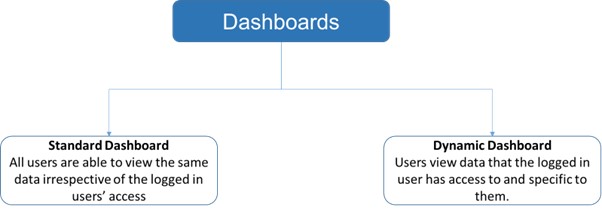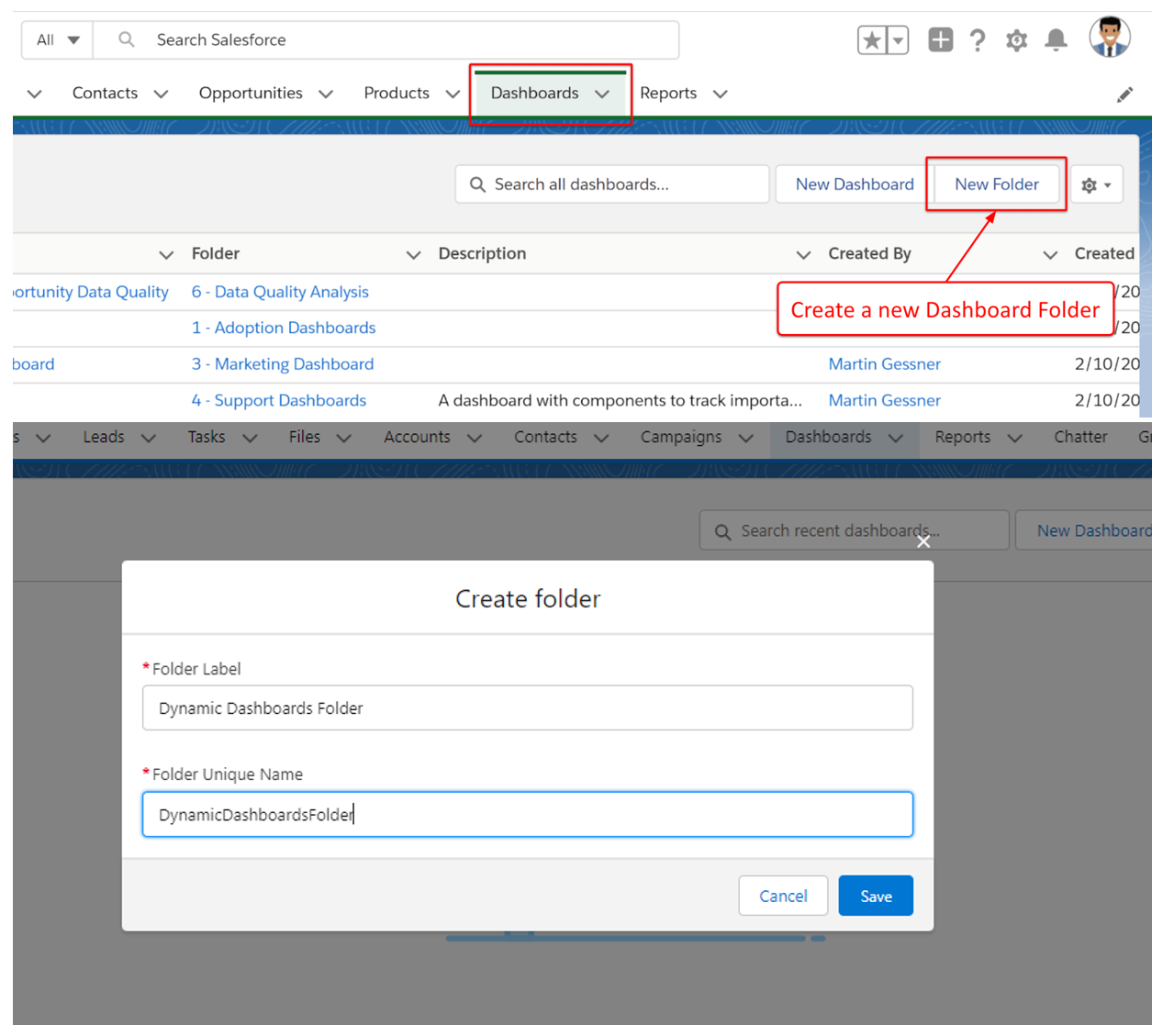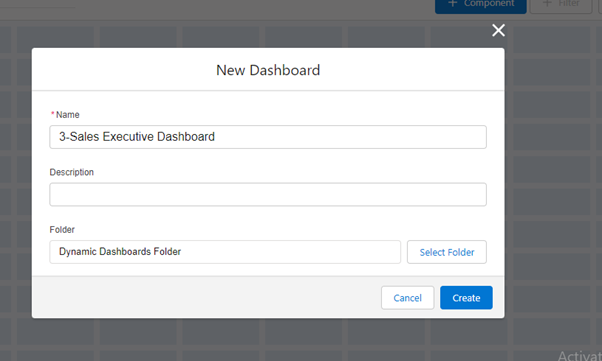
Salesforce is a powerful, low-maintenance Customer Relationship Management (CRM) system with a user-friendly interface and easy customization. It’s the platform of choice for digitizing the front office experience. Yet capturing your data in Salesforce is only half the job. For the other half, you’ll need to generate reports and analyze the data. Many organizations don’t fully leverage the powerful Salesforce reports and dashboards.
In this article, we’ll cover:
Newsletter sign up
"*" indicates required fields
Why Dynamic Salesforce Dashboards Matter
A Salesforce dashboard is a combination of information streams, each made up of a single report. These dashboards are very useful when you or your stakeholders need a visual representation of your data. Salesforce dashboards also help you compare and interpret your data. You can use them to track metrics and your organization’s performance in real-time.
Not everyone needs the same level of access to data in an organization. The stakeholders with the highest level of access are often the C-suite leaders, who need to see the entire organization’s information. On the other hand, the regional head may only need access to their region’s data. Salesforce dynamic dashboards facilitate this granular sharing and save extra work for system admins while increasing security.
Let’s dig into these dynamic Salesforce dashboards to help you maximize the benefits available.
Dynamic vs Standard Dashboards in Salesforce

Standard Dashboard Overview
In the standard dashboard, all users can see the same data, no matter who has logged in and what data they have access to. You can use the standard dashboard to display company-wide information that everyone should be able to tap into. For example, all stakeholders might have permission to see the year-end goal for the entire company.
Dynamic Dashboard Overview
A Salesforce dynamic dashboard is a single dashboard that lets you show key information to several different types of stakeholders like employees, CEOs, CFOs, clients, and customers, depending on their permissions and needs, without working to create different dashboards for each one.
Salesforce Dynamic dashboards look the same as standard dashboards, but they only show data relevant to specific logged-in users. For example, the sales head for the northern sales territory will see the northern territory sales data, while the southern territory sales head will see only the southern territory sales data. This filtering by logged-in users happens automatically and dynamically at runtime while Salesforce is loading the dashboard.
What Are the Best Salesforce Dashboards & Reports? Find out in our helpful guide.
Salesforce Dynamic Dashboard
Why Use a Dynamic Dashboard
Dynamic dashboards are extremely useful for sales teams, departments, and companies that need to manage and share data without spending hours generating different reports for employees at different levels of the business.
For example, instead of creating multiple dashboards for senior sales staff, sales team leads, and front-line sales employees, you can create just one dynamic dashboard that shows the right data to the right stakeholders. An outbound sales agent might see just their targets and performance, while a department manager can see figures and goals for their department and for all direct reports.
This setup removes a lot of the administrative effort normally required to create and maintain different dashboards for every level of data access. You can use one dynamic dashboard to selectively show data like this, based on record access for multiple users.
Benefits Of Using a Dynamic Dashboard
-
- They reduce the number of dashboards that system admins need to create and maintain.
- Dynamic dashboards always provide real-time data based on the access settings for different users.
- It’s easy to securely provide access to dynamic dashboards to the right users without worrying about data being viewed by unauthorized users.
- When users get access to more records, they automatically see the data related to those records in a dynamic dashboard.
- Dynamic dashboards are a useful way to display user-specific data and track goals or milestones for individual users.
How To Set Up A Dynamic Dashboard
Setting up a dynamic dashboard in Salesforce is similar to setting up a standard dashboard, but with one difference. Dynamic dashboards run according to the security settings of the user viewing the dashboard. The running user should be set as “Run as Logged-in User” instead of the default “Run as Specified User.”
To create a dynamic dashboard, follow the steps below:
-
- First, we need to create a dashboard folder to store and control access to the dashboard. In the dashboard tab, click on the New Folder button and enter a name for the dashboard. The “Folder Unique Name” will be generated automatically.

2. Go to the dashboard folder and click on the dropdown next to the New Folder button, then click Share. Share the folder with different users and define their access levels.
3. Click the New Dashboard button and enter the name of the dashboard, then select the folder to store the dashboard. In this case, it’s stored in the “Dynamic Dashboard Folder.” Click Create.

4. Now on the screen, click the small gear icon next to the Save button to open the properties window. In the View Dashboard As settings, select the dashboard viewer. This refers to the logged-in user. Click Save.
5. The dashboard has been converted into a Salesforce dynamic dashboard.
6. You can click the + Component button to add required components to the dashboard and then save it.
The dashboard is now a Salesforce dynamic dashboard, which means it will show data according to logged-in user access levels. Users will not be able to see data for inaccessible records. Thus, it’s more secure than a standard dashboard.
Financial Dashboards with Accounting Seed
Utilizing Financial Dashboards in Salesforce
Salesforce financial dashboards are a type of dynamic dasboard, and are a perfect way to present an overall financial overview to top management. Salesforce pulls data from different objects and fields into these dashboards, which are created from report components.
To get the most out of your financial dashboards, follow these tips:
-
- Instead of creating multiple dashboards for different levels of access, consider creating one Salesforce financial dynamic dashboard that shows different data to different users. For example, the CEO has the highest level of access and will see all the company’s data, such as the P&L report for the entire business. Meanwhile, the head of the e-commerce department will only see the P&L report for that department.
- There’s a dynamic dashboards limit in Salesforce for each org. In the Salesforce Enterprise Edition, you can create up to five Salesforce dynamic dashboards. With the Performance Edition and the Unlimited Edition, you can create 10 dynamic dashboards. With the Developer Edition, you’ll be able to set up three dynamic dashboards. You can ask your Salesforce account executive about increasing the limit in the Enterprise, Performance, and Unlimited editions as a paid feature.
- Since there are limitations on the number of dynamic dashboards you can create in your Salesforce org, you should plan out the number of dynamic financial dashboards you’ll want before creating them.
Learn more about the greatest financial dashboards for your business in our guide, 20 Best Financial Dashboards for Making Business Decisions.
For more information Salesforce’s Editions.
Top Accounting Seed’s Financial Dashboard Software
Accounting Seed is one of the top-rated apps on the Salesforce AppExchange, combining general ledger, accounts receivable, accounts payable, project accounting, fund accounting, automated billing, inventory management, configurable invoice formats, and online payment processing in one easy-to-use platform.
Accounting Seed’s Salesforce native accounting platform makes the Salesforce tool much more powerful. The Salesforce CRM platform handles the front-office experience, while Accounting Seed takes over back-office management. With Accounting Seed, your organization has access to all the financial information needed to create reports and dashboards, all within the Salesforce Platform.
Here are the top dashboards you can use with Accounting Seed’s Salesforce integration:
-
- Management Dashboards: You can create management dashboards with Accounting Seed that use management reports that display transactional data. These dashboards include interactive charts and graphics that the user can fine-tune to drill down into the data.
- Standard Financial Dashboards: The Salesforce standard financial dashboards use financial reports to share traditional accounting analyses of your data. They help your users access transactional data and filter by ledger and accounting variables. You can access the following reports with the standard dashboards:
-
-
-
- Profit and Loss
- Profit and Loss vs Budget
- Balance Sheet
- Trial Balance
- Cash Flow
- Ledger Inquiry
-
-
-
- Custom Financial Dashboards: You can create custom financial dashboards with Accounting Seed that support custom calculations. Some custom dashboards often used by customers are:
-
-
-
-
-
- Reporting multiple entity consolidated results.
- Custom profit and loss analysis.
- Department budgeting.
-
-
-
-
Find out how you can use Accounting Seed to transform financial workflows in Salesforce and power your financial dashboards all within the same platform. Request a demo of Accounting Seed today.
Key Takeaways
To leverage the full potential of the powerful Salesforce CRM platform, you need to use the different levels of dashboards Salesforce offers. Some of these dashboards are pre-built and some are custom-made. All of them will help you analyze your company’s performance so you can make more informed, data-driven decisions. Here are a few key takeaways:
-
- You can use Salesforce dynamic dashboards to limit the number of dashboards you need to create and maintain. You can set up one dynamic dashboard that shares data with stakeholders who have different levels of access to the records in the Salesforce Platform.
- There are limits to the numbers of dynamic dashboards you can use in Salesforce, depending on the Salesforce edition you subscribe to. Plan your dashboard deployment accordingly.
- Accounting Seed’s financial dashboards can unlock both backend and frontend insights for your organization, all within the Salesforce CRM platform.
See Accounting Seed in action
Get a close-up view of how accounting on Salesforce can eliminate the need for costly integrations—and silos of mismatched information—by sharing the same database as your CRM.



